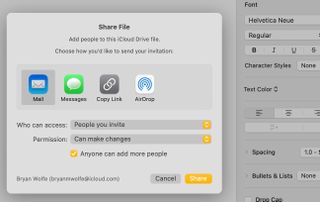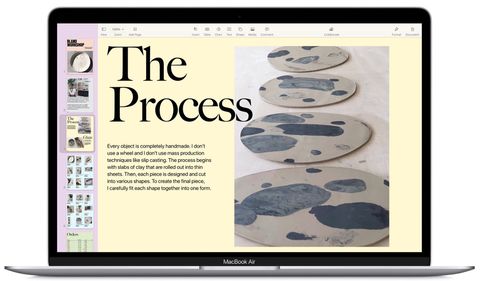TechRadar Verdict
A suitable free solution for those exclusively in the Apple bubble. A tough sell for everyone else despite its easy of use and general feature set.
Pros
- +
Offers word processing and desktop publishing solutions
- +
Compatible across multiple Apple devices
- +
Easy to convert to Microsoft Word
- +
Free for Apple devices
Cons
- -
Fewer features than Microsoft Word, Adobe Indesign
- -
Limited user base
- -
You can't open Pages files on other apps
Why you can trust TechRadar
First introduced in 2005 for Mac, Apple Pages is marketed as an easy-to-use word processor that serves as a basic desktop publishing solution. Apple Pages for iPad arrived in 2010 with a handheld version launching a year later for iPhone and iPod touch.
Over the years, Apple Pages has picked up various features such as more templates, object insertion such as charts, and the ability to play video and audio files directly from the document. The most recent software update, in September 2021, added instant translation into up to 11 languages, more collaboration tools, and more.
Apple Pages: Plans and pricing
It wasn't that long ago when Apple charged for the iWork suite, including Pages, Numbers, and Keynote. Since 2017, however, the suite has been entirely free to use across multiple devices, including Mac, iPhone, iPad, and the web. In addition, Apple's iMovie and GarageBand also became free at the same time.

Apple Pages: Features
Word processing apps are all the same at the core in many respects. They all, for example, make it possible to write documents using fonts and page sizes of the user's choosing. Most solutions also do an impressive job of allowing end-users to insert various objects in documents such as images, shapes, charts, and others.
Move beyond the surface, and Apple Pages' unique features become apparent. Four distinct features especially stand out, starting with its long list of available templates and ending with its conversion tools.
Since first being introduced over 15 years ago, Apple Pages has always been known for its beautifully designed templates. Arranged into multiple categories, the template selector highlights the many mockups, including letters, stationery, resumes, among others. These templates are easy to customize and are often updated with each new app release. You can use any of these templates to start a new document or begin from scratch. It's also possible to create templates to use as starting points for future documents. Better still, you can access them on any device using iCloud.
Apple's flair for creativity isn't limited to the Pages templates. The app is also packed with incredible ways to make the text your own by filling it with color gradients or images. For a document as a whole, consider adding photos, galleries, videos, charts, audio clips, math equations, and much more.

The slick integration between various Apple devices is another can't miss feature of Pages. Whether you're moving from Mac to iPad, web to iPhone, etc., you can take comfort in knowing your documents are accessible and secure at any time as long as they're being saved to iCloud. For example, you can start a document on your home iMac, then make edits in class on your iPad. Do you want to add an important point on the fly? Pick up your iPhone and make tweaks at any time. Thanks to the new Screen View on iPhone, the content looks perfect even on the smaller screen, making reading and editing very easy.
This brings us to another critical Apple Pages feature: document sharing and collaboration. Although the iWork suite is rightly criticized by many for not being available on Windows and Android, Apple makes it amazingly easy to share content among other Apple users. You can now, for example, add a Pages document to a shared iCloud Drive folder and create and share books, then get them published to Apple Books.
Throughout the sharing, turn on comments so you can see everyone's edits. Additionally, add comments or reply to others to create threaded conversations.
Moving on, although native Pages documents can't be opened outside of the app, over the years, Apple has made it easier to convert files to other formats. These include PDF, EPUB, and yes, Microsoft Word, and more. Although the iWork suite is rightly criticized by many for not being available on Windows and Android, Apple makes it amazingly easy to share content among other Apple users. You can now, for example, add a Pages document to a shared iCloud Drive folder and create and share books, then get them published to Apple Books.
Throughout the sharing, turn on comments so you can see everyone's edits. Additionally, add comments or reply to others to create threaded conversations.
Moving on, although native Pages documents can't be opened outside of the app, over the years, Apple has made it easier to convert files to other formats. These include PDF, EPUB, and yes, Microsoft Word, and more.

Apple Pages: Interface and in use
If you're familiar with Microsoft Word, and you almost certainly are, you've experienced Microsoft's Ribbon. Providing cluttered access to everything the top-selling word processor can do, the Ribbon centrally sits at the top of the app. It automatically adjusts its viewable tabs based on what you're doing at the time.
Apple Pages takes an entirely different approach. Instead of a ribbon, you'll find a somewhat vacant toolbar and optional sidebars. The minimalist approach carries over to Apple's Numbers and Keynote. The setup works because of the intuitiveness of it all. Even first-time users know, for example, what's likely to be discovered under the toolbar's Table, Chart, and Media links. The same goes for the Format link that opens a feature-rich sidebar where you can adjust the document style, layout, and more.
Apple Pages: Support
Apple provides iWork support through its website. You can also find a robust community of Pages users in the same location. Free user guides are offered on Apple Books.
Apple Pages: The competition
Beyond Microsoft Word, there are many free and paid word processor solutions available. These include LibreOffice Writer, WPS Office Free Writer, and others.
When it comes to word processing solutions, there's truly nothing better than Microsoft Word, which is available across multiple platforms, including Mac, Windows, and mobile. Adobe's In Design is also much much than Pages for desktop publishing.
Check out the best free word processors and the best word processors for tablets.
Apple Pages: Final verdict
If you only use Apple devices and don't need to share documents with non-Apple users, Pages is perhaps the best solution. Its interface is intuitive and minimalistic by design. Plus, its sharing capabilities are impressive. And because it's free, you have nothing to lose.
On the other hand, business users, including professional creatives, will need to look elsewhere for better tools and increased compatibility.
We've also featured our Microsoft Word review and a full iWork review.
Bryan M. Wolfe is a staff writer at TechRadar, iMore, and wherever Future can use him. Though his passion is Apple-based products, he doesn't have a problem using Windows and Android. Bryan's a single father of a 15-year-old daughter and a puppy, Isabelle. Thanks for reading!


